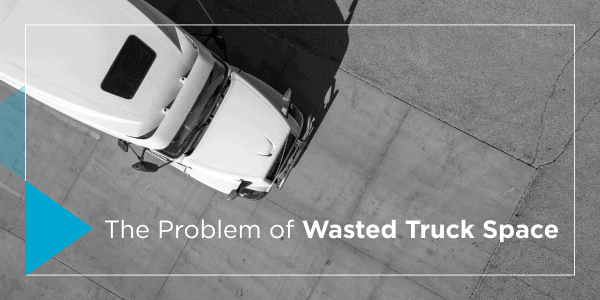
Why have transportation costs risen over the years? Every single business that moves freight asks this question day after day, and while many factors contribute to the rising (and often unstable) costs of shipping freight, one new study shines a light on a major contributor: empty trailer space. Every bit of empty space on a commercial truck is money out the window. While it does cost more in fuel to move heavier (and thus fuller) trailers, the cost efficiency is much greater for everyone when hauling a full load.
How Much Space is Wasted on the Average Truckload?
A new study surveyed 1,000 transportation decision-makers in the U.S. from various industries, and it’s key finding was a bit surprising: a massive 43% of truckloads moved in the U.S. are partially empty. On average, every truckload has about 29 linear feet of free space. That essentially means that one in four truckloads are making trips while completely empty, and this inefficiency is costing shippers money.
The Costs of Wasted Truck Space
LTL shipping can be a cost-effective way to move freight, when smaller shipments are sent economically. However, this research reveals some hidden costs that come with LTL freight when it’s not handled efficiently, thus resulting in empty trailer space. According to the earlier mentioned study, the average enterprise shipper is incurring up to $6.3 million annually in damage and lost claims on top of unexpected accessorial fees and added labor costs for employees managing these issues. This is because LTL freight is generally handled more times than consolidated shipments.
Decreasing Freight Costs by Filling Trucks
Partial Truckload (PTL) shipping, also known as freight consolidation, is designed specifically for shipments that don’t require a full truck but are too large for less-than-truckload (LTL) shipping. PTL allows multiple shippers to combine their smaller shipments into a single truckload, optimizing space and reducing overall transportation costs. It also helps significantly cut down on wasted trailer space.
In PTL shipping, shippers pay only for the portion of the truck they use, rather than the entire truck. Compatible shipments are then matched, which ensures efficient use of trailer space and resources. By consolidating loads, PTL reduces the number of trips required, minimizing fuel consumption and carbon emissions while also often allowing for faster delivery times when compared to traditional LTL shipping.
How PTL Shipping Helps Cut Costs
- Optimized Freight Space: PTL shipping maximizes the use of available truck space by consolidating shipments from multiple shippers. This reduces the cost per shipment as the expenses are shared among multiple parties. By only paying for the space used, shippers avoid the high costs associated with booking a full truck.
- Reduced Handling: unlike LTL shipping, which often involves multiple transfers and handling at various terminals, PTL shipments typically follow a more direct route. This minimizes handling, reducing the risk of damage and associated costs.
PTL vs. LTL: Cost Savings
While LTL can be a cost-effective way to send freight, PTL offers some unique benefits from a cost perspective:
- Lower Rates per Pound: PTL often offers lower rates per pound compared to LTL. In LTL shipping, rates are typically calculated based on the shipment’s weight and dimensions, leading to higher costs for larger, heavier items. PTL, on the other hand, provides more predictable pricing as shippers pay for the space used, not just the weight.
- Reduced Accessorial Fee’s: LTL shipments frequently incur additional fees for overlength pallets, reweighs, reclasses, and more. PTL shipping minimizes these fees by removing freight from the LTL network where it is susceptible to after the fact charges.
- Minimized Damage and Claims: with fewer touchpoints and less handling, PTL shipments have a lower risk of damage. This reduces the likelihood of filing claims, which can be both time-consuming and costly. The streamlined process of PTL shipping ensures that goods arrive in better condition, saving money on potential repairs or replacements.
- Faster Transit Times: PTL shipping often results in faster delivery times compared to LTL, which can experience delays due to multiple stops and transfers. Faster transit means shippers can turn over their inventory more quickly, reducing storage costs and improving cash flow.
Helping Shippers Make the Right Decision for Their Freight
At King Solutions, we specialize in both PTL and LTL shipping. That means you get honest opinions on what’s right for your freight and your business. We not only help you make the right decision for your budget, but we also help you implement your custom logistics plan from start to finish. Whether you are looking for a PTL or LTL solution, we can help you bring efficiency and affordability to your supply chain, allowing you to move freight quickly and more cost effectively. Contact us today for a free consultation.







 Joel Rice
Joel Rice